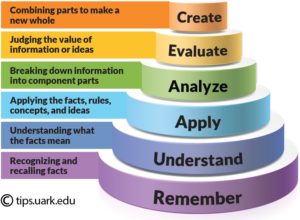Once the semester has ended and you have had time to rest and recover, go back to any notes you have made throughout the semester, as well as student comments on the course. Make sure to make any necessary changes to assignments or other documents as soon as possible so you don’t forget to do so later.
When you being to plan the next semester’s course, use the feedback you have collected to think more consciously about your course goals. Make sure that your course goals are clear and realistic, and that they are varied in terms of skill level. Bloom’s taxonomy (featured below) is a helpful tool for creating a diverse set of course goals.
Of course, your goals will vary widely depending on the type of class you’re teaching. A general rule of thumb is to articulate one or two course goals corresponding to the lower tiers (remember, understand, apply) of Bloom’s taxonomy and one or two course goals at the higher levels (analyze, evaluate, create). Below are some examples of course goals from two different disciplines:
- Intro to Chemistry: Upon successful completion of this course, you will be able to:
- Identify components of chemical formulae
- predict simple chemical formulas and geometries.
- understand the reasoning for the periodic table’s structure as well as be able to predict trends involving ionization energies, electron affinities, and other chemical properties.
- be able to describe and solve problems involving the ideal gas law and simple thermodynamic relationships.
- Writing and Rhetoric: Upon successful completion of this course, you will be able to:
- Identify rhetorical strategies and understand the way they are used in our everyday lives.
- Analyze and evaluate the effectiveness of textual and visual arguments.
- Create your own visual and textual arguments that demonstrate an awareness of your audience and effectively construct a truth about yourself and/or the world using rhetorical techniques.
The idea is to make sure that students are being challenged to tackle difficult problems and questions but that they also have basic knowledge provided by the lower level learning goals in order to accomplish these higher level tasks. After you have created your course goals, you can begin planning lesson plans and assignments around them.
This blog post is a preview of what will be covered in The Foundations of Teaching workshop series next semester. If you are not already on our mailing list, please email kaneb@nd.edu in order to sign up so that you are notified when workshops are open for enrollment.
Further Reading on Backward Course Design
Jo Handelsman, Sarah Miller, and Christine Pfund, Scientific Teaching

